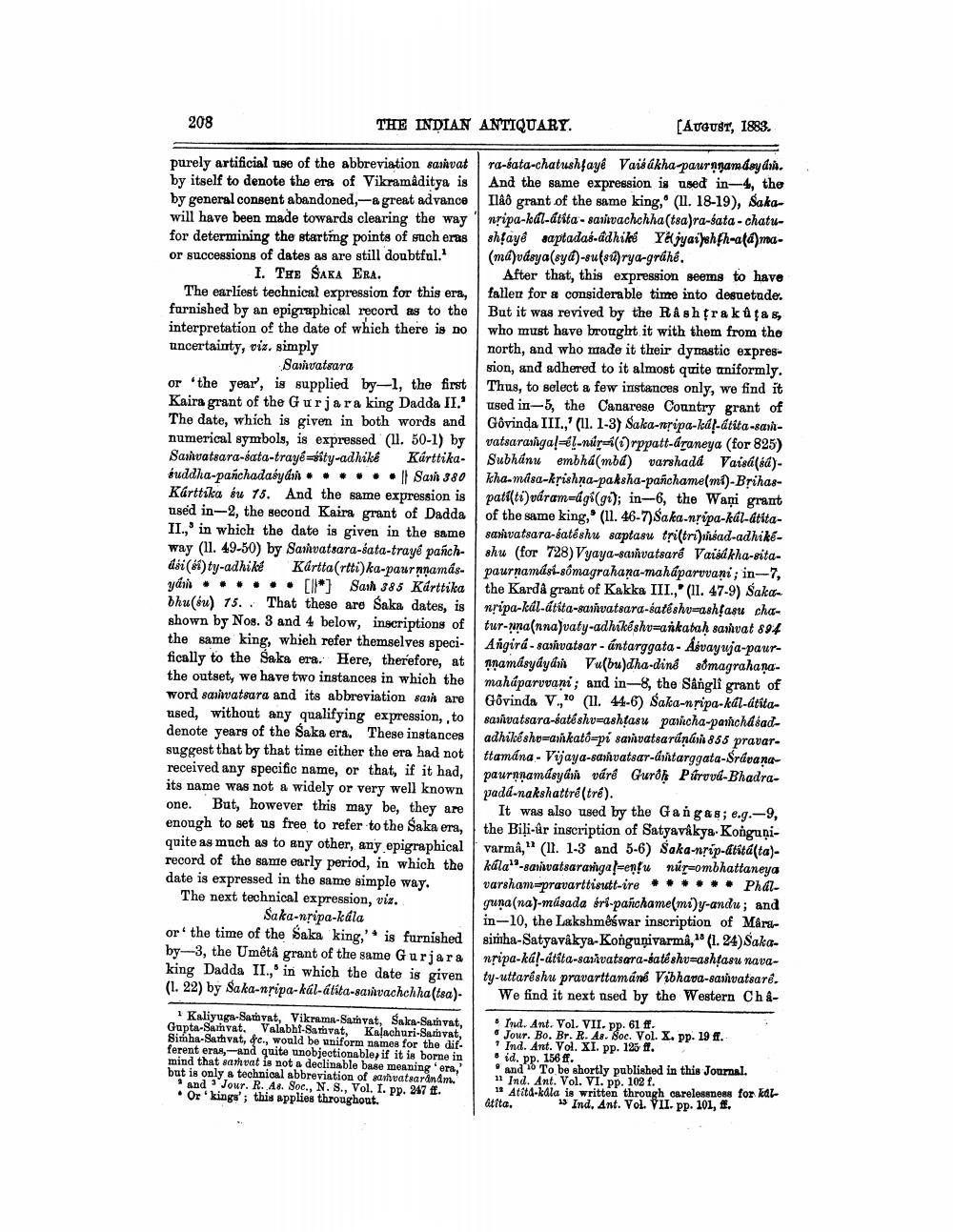________________
208
THE INDIAN ANTIQUARY.
(AUGUST, 1883.
purely artificial use of the abbreviation sasivat ra-sata-chatushfayê Vaisakha paurnnamdsydra. by itself to denote the era of Vikramaditya is And the same expression is used in-4, the by general consent abandoned,-a great advance Il&ð grant of the same king, (11. 18-19), Sakawill have been made towards clearing the way 1 nipa-kál-atita - sariwachchha(tsa)ra-sata-chatufor determining the starting points of such eras shfayê saptadas.ddhill Yel jyaiyshfh-ata) maor successions of dates as are still doubtful. (md)vásya (syd)-suf surya-gráhé. I. THE SAKA ERA.
After that, this expression seems to have The earliest technical expression for this era, fallen for a considerable time into desuetude. furnished by an epigraphical record as to the But it was revived by the Rashtrakatas, interpretation of the date of which there is no who must have brought it with them from the uncertainty, viz. simply
north, and who made it their dynastic expresSaravatsara
sion, and adhered to it almost quite uniformly. or 'the year', is supplied by-1, the first Thus, to select a few instances only, we find it Kaira grant of the Gurjara king Dadda II.' used in-5, the Canarese Country grant of The date, which is given in both words and Govinda III.,' (11. 1-3) Saka-nipa-káp-atita-sarinumerical symbols, is expressed (11. 50-1) by vatsaranga!!-núr=(Orppatt-draneya (for 825) Saravatsara-sata-trayé=sity-adhik Kürttika- Subhanu embhamba) varshada Vaisá(ed)Suddha-panchadasyan ...... Sain 380 kha-masa-krishna-paksha-panchame(mi)-BrihasKürttika su 75. And the same expression is patísti)váram=igi(gu); in-6, the Waņi grant used in-2, the second Kaira grant of Dadda of the same king,' (11. 46-7) Saka-nripa-kal-atitaII., in which the date is given in the same savivatsara-satéshu saptasu triftribusad-adhikeway (11. 49-50) by Sarivatsara-sata-trayé pañch- shu (for 728) Vyaya-samvatsaré Vaisd kha-sitaúsi(ći) ty-adhike Kartta(rtti)ka-paurinamás- paurnamási-sômagrahana-maháparvvari; in-7, yári ...... [M] Sash 385 Kárttika the Kardâ grant of Kakka III.,' (11. 47-9) Sakabhu(6u) 15. . That these are Saka dates, is nripa-kal-atita-samvatsara-satéshv=ashtasu chashown by Nos. 3 and 4 below, inscriptions of tur-una(nnajuaty-adhikéshuwaikatah sanhvat 894 the same king, which refer themselves speci- Angirá - sasivatsar - ántarggata - Asvayuja-paurfically to the Saka era. Here, therefore, at nnamásyáyári Vubu)dha-dino smagrahana. the outset, we have two instances in which the maháparuvani; and in-8, the Sangli grant of word sariwatsara and its abbreviation sarh are Govinda V.,to (11.44-6) Saka-n ripa-kal-atitaused, without any qualifying expression, to saskvatsara-satéshuwashtasu pavicha-panchdeaddenote years of the Saka era. These instances adhikéshu=arñkatô=pi samvatsarúnári 855 pravarsuggest that by that time either the era had not ttamána - Vijaya-samvatsar-dintarggata-Srdvanareceived any specific name, or that, if it had, paurnnamásyári váré Guros Púruvd-Bhadraits name was not a widely or very well known padd-nakshattré (tré). one. But, however this may be, they are It was also used by the Gangas; e.g.-9, enough to set us free to refer to the Saka era, the Biļi-ur inscription of Satyavikya Konguņiquite as much as to any other, any epigraphical varma," (17. 1-3 and 5-6) Saka-nsip-atita(ta)record of the same early period, in which the kala"-sariwatsarangal-entu núr=ombhattaneya date is expressed in the same simple way. varsham=pravarttist-ire ...... PhalThe next technical expression, viz.
guna(na)-müsada sri-pañichame(mi)y-andu; and Saka-npipa-kdla
in-10, the Lakshmëśwar inscription of Maraor the time of the Saka king' is furnished simha-Satyavákya-Kongunivarma, (1.24) Sakaby-3, the Umêtâ grant of the same Gurjara npipa-kal- átita-sarávatsara-satéshv=ashtasu navaking Dadda II., in which the date is given ty-uttari shu pravarttamáné Vibhava-sashvatsaré. (1. 22) by Saka-nripa-kül-atita-sanvachchha(tsa). We find it next nsed by the Western Cha
Kaliyuga-Samvat, Vikrama-Sarhvat, Saka-Sathvat, Gapta-Samvat. Valabhi-Samvat, Kalachuri-Samvat, Sinha-Sarhvat, &c., would be uniform names for the different erns, and quite unobjectionable, if it is borne in mind that sanoat is not a declinable base meaning 'era.' but is only a technical abbreviation of gaxhuatsardndm.
and Jour. R. As. Soc., N. S., Vol. I. pp. 247 f. • Orkings'; this applies throughout.
. Ind. Ant. Vol. VII. pp. 61 ff.
Jour. Bo. Br. R. As. Soc. Vol. X. pp. 19 ff.
Ind. Ant. Vol. XI. pp. 125 ft. • id. pp. 156 ff. • and * To be shortly published in this Journal. 11 Ind. Ant. Vol. VI. pp. 102 f.
1 Atâta-kala is written through carelessness for kalatsta. 3 Ind. Ant. Vol. VII. pp. 101, #.




